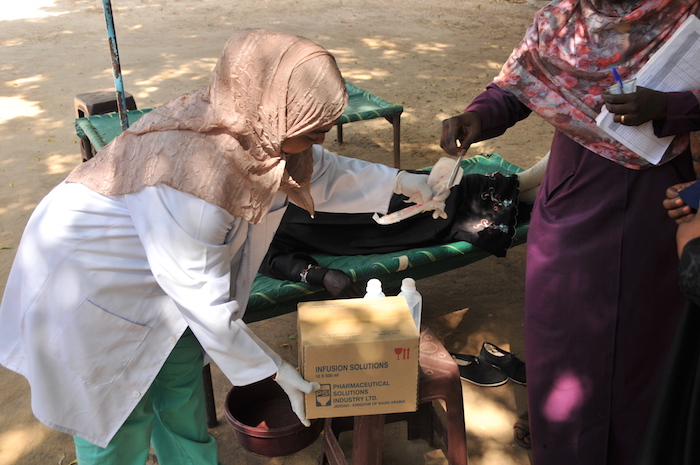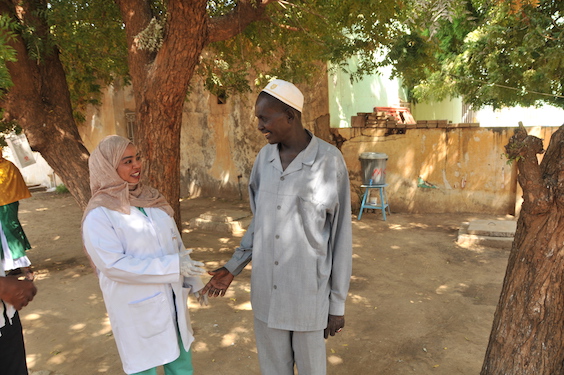Acute watery diarrhoea (AWD) has affected Sudan since August 2016, infecting over 36 000 people and killing over 800. Over the next 3 weeks, read along as we introduce you to the people living with and fighting against this deadly disease.
This week: Somaia Abdallah (28) works as a nurse in Kosti CTC, a special facility for AWD cases.
 Nurse Somaia Abdallah (l) demonstrates AWD treatment at Kosti CTC (Photo: WHO Sudan/Simon van Woerden).
Nurse Somaia Abdallah (l) demonstrates AWD treatment at Kosti CTC (Photo: WHO Sudan/Simon van Woerden).
In the AWD outbreak emergency, Cholera Treatment Centers or “CTCs” are a key health facility. Since AWD and cholera have similar symptoms and response measures, a CTC can also treat cases of AWD. Sudan’s Health Ministry has set up dozens of these CTCs across the country since the start of the AWD outbreak in August of 2016, with support from WHO and various generous contributions from SHF, CERF, and USAID. In total, the Health Ministry set up over 200 temporary and permanent CTCs since the beginning of the outbreak, with an average ten health professionals supporting.
Inside these CTCs, much of the day-to-day heavy lifting is done by the men and women in nursing uniforms. They administer fluids and life-saving medicine, help maintain a hygienic, sanitary environment, and work around the clock to do whatever else is necessary to stop the needless deaths from AWD.
Somaia Abdallah (28) is one of these people. Described as “one of the ten heroic nurses of Kosti’s CTC”, Somaia began working in the AWD outbreak response on April 16 last year, in support of Sudan’s Health Ministry’s efforts to stem the deadly outbreak. Somaia: “When I came in, it was the high point of the outbreak in White Nile. We were getting as many as 120 people per day coming to our facilities, all with symptoms of AWD.” In addition to diarrhoea and vomiting, the patients would have loose skin, be very eager to drink, and would not urinate. That’s when Somaia would know: this person needs fluids fast, or face certain death.
Once a case is brought in, Somaia and her colleagues immediately start treatment to stop and reverse the dehydration. Moderate cases are given Oral Rehydration Solution (ORS) whereas severe cases would receive several cannula, thin tubes, in their limbs to administer fluids. Somaia: “Normally after two to three days, patients would begin to rehydrate, and the diarrhoea would stop. Because we have 250 beds here, sometimes patients would come in so quickly that they would have to share a bed.”
 Nurse Somaia (l) and her former patient Hammad Yousif Ibrahim (r) at the CTC in Kosti (Photo: WHO Sudan/Simon van Woerden).
Nurse Somaia (l) and her former patient Hammad Yousif Ibrahim (r) at the CTC in Kosti (Photo: WHO Sudan/Simon van Woerden).
Before the AWD outbreak hit White Nile, Somaia was already working as a nurse. To begin working in the CTC, she received training from WHO on AWD case management and recognition. She also learned how to take care of patients and dispose safely of medical and human waste. With support from WHO, through Sudan’s Humanitarian Fund (SHF), and working hand in hand with Sudan’s State Health Ministry, nurses like Somaia went to work saving patients’ lives every day.
Although in White Nile nearly 9,000 people were infected with AWD, the most of any state in Sudan, nearly 99% of them were saved, in large part because of the indefatigable work of Somaia , and her fellow nurses . However, even hero nurses cannot perform magic. Somaia also saw patients that did not make it. Hesitantly, she shares her experience: “Most cases that did not get better would arrive to the CTC too late. For some, living far away from the health facilities is a factor. We would give them 4 cannulae, 6, or even 8 - but for some it would just be too late.” There was hardly any time for mourning: patients that were still alive and needed help were waiting.
“We would work twelve hour shifts per day, every day, without weekend”, says Somaia. “It’s definitely a tough job, but I love it.” What kept her going in the difficult hours was one word: “Humanity. The work is human, these people are human. I cannot stand by and just do nothing.”





